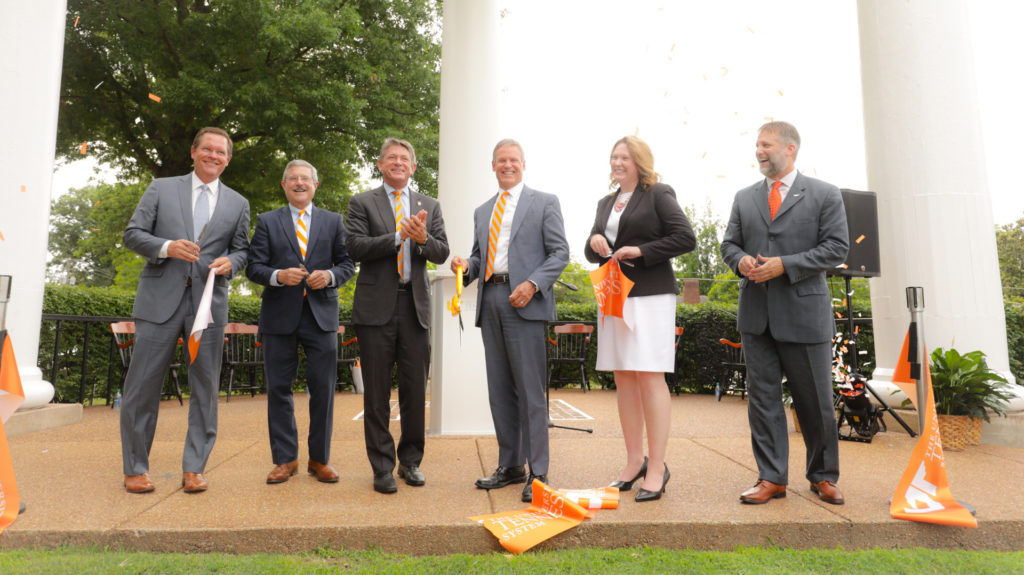Pulaski—This morning Gov. Bill Lee, accompanied by local and state officials, joined together to officially celebrate UT Southern, the newest campus to join the UT System in more than 50 years.
Lee said when he heard about the proposed acquisition, he knew it would be good for the state.
“Our state is better today than it was yesterday because of UT Southern,” Lee said at the ribbon cutting event to mark UT Southern’s beginning.
The ribbon cutting capped off two days of celebration that began Wednesday evening with a “Midnight Merger” block party in downtown Pulaski. UT System President Randy Boyd led a crowd of about 1,000 people in front of the Giles County Courthouse Wednesday night. He counted down the last seconds of June and to welcome Martin Methodist College’s transition to UT Southern, which took effect on July 1. Giles County officials issued a proclamation naming July 1 as UT Southern Day as part of Thursday’s event.
“UT Southern is more than just our newest addition,” Boyd said. “It represents opportunity, revival, long-term economic success and forward momentum in the southern Middle Tennessee region.”
Mark La Branche, who was president of Martin Methodist College and now chancellor of UT Southern, noted that the college will continue its purpose since its founding—providing a higher education to the area.
“Our mission continues and it’s expanding. It’s going to be more affordable, more accessible with more opportunities,” La Branche said.
For the past year, UT and Martin Methodist College engaged in a comprehensive due diligence process to initiate the accession of the 151-year-old private college into the UT family. In the spring, Lee included $5.1 million in recurring and $1 million in non-recurring funds in the state’s budget, which the Tennessee General Assembly approved.
Approval by the Tennessee General Assembly, the Southern Association of Colleges and Schools Commission on Colleges and other agencies occurred before June 25, when the UT Board of Trustees approved UT Southern to become the first university to join the UT System since UT Chattanooga in 1969. Pellissippi State Community College was the last public higher education institution to join the state in 1974.
Tennessee Republican House Speaker Cameron Sexton emphasized the increased economic development opportunities available with the addition of UT Southern.
“This is a great opportunity to keep your brain trust, to keep your families, to keep your kids and incorporate more people into what rural Tennessee life is like,” Sexton said.
Pulaski Mayor Pat Ford, who also serves on the faculty of UT Southern, noted Boyd spoke of the work starting after the celebration.
“So how about we cut a ribbon and go to work?” Ford said.
In addition to the new university name, Flame the FireHawk will represent UT Southern’s 19 athletic teams as the new school mascot. The mythical creature with thunder in its wings and fire in its eyes represents the fifth mascot for the university in its history. Uniforms will be debuted in late August during welcome week festivities.
UT Southern began as Martin Female College in 1870 to offer education for women. Thomas Martin of Pulaski, Tennessee, endowed the college to fulfill his daughter, Victoria’s, dying wish to establish a school for women. In 1938, it became a coeducational college along with a new name: Martin College. In 1986, its name was changed to Martin Methodist College, and, in 1993, it became a four-year institution.
Located in Pulaski, about 70 miles south of Nashville and 40 miles north of Huntsville, Alabama, UT Southern—the fourth undergraduate campus in the UT System—is the only public four-year institution of higher education between Chattanooga and Memphis along Tennessee’s southern border. About 800 students are enrolled in more than 30 academic programs of study. The acquisition has allowed for a 60% decrease in tuition, resulting in a private school experience at a public-school cost.
